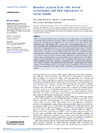Identificador persistente para citar o vincular este elemento:
https://accedacris.ulpgc.es/jspui/handle/10553/77926
| Campo DC | Valor | idioma |
|---|---|---|
| dc.contributor.author | Vargas-Bello-Pérez, Einar | en_US |
| dc.contributor.author | Márquez-Hernández, Roberto I. | en_US |
| dc.contributor.author | Hernández Castellano, Lorenzo Enrique | en_US |
| dc.date.accessioned | 2021-03-04T13:07:17Z | - |
| dc.date.available | 2021-03-04T13:07:17Z | - |
| dc.date.issued | 2019 | en_US |
| dc.identifier.issn | 0022-0299 | en_US |
| dc.identifier.uri | https://accedacris.ulpgc.es/handle/10553/77926 | - |
| dc.description.abstract | Milk is an important protein source in human diets, providing around 32 g protein/l (for bovine milk, which constitutes some 85% of global consumption). The most abundant milk proteins are α-lactalbumin, β-lactoglobulin, αs-casein, β-casein, and κ-casein. Besides their nutritional value, milk proteins play a crucial role in the processing properties of milk, such as solubility, water bonding, heat stability, renneting and foaming, among others. In addition, and most importantly for this review, these proteins are the main source of bioactive components in milk. Due to the wide range of proposed beneficial effects on human health, milk proteins are considered as potential ingredients for the production of health-promoting functional foods. However, most of the evidence for bioactive effects comes from in vitro studies, and there is a need for further research to fully evaluate the true potential of milk-derived bioactive factors. Animal genetics and animal nutrition play an important role in the relative proportions of milk proteins and could be used to manipulate the concentration of specific bioactive peptides in milk from ruminants. Unfortunately, only a few studies in the literature have focused on changes in milk bioactive peptides associated to animal genetics and animal nutrition. The knowledge described in the present review may set the basis for further research and for the development of new dairy products with healthy and beneficial properties for humans. | en_US |
| dc.language | eng | en_US |
| dc.relation.ispartof | Journal of Dairy Research | en_US |
| dc.source | Journal of Dairy Research [ISSN 0022-0299], v. 86(2), p. 136-144 | en_US |
| dc.subject | 3104 Producción Animal | en_US |
| dc.subject.other | Animal nutrition | en_US |
| dc.subject.other | Bioactive peptides | en_US |
| dc.subject.other | Dairy cow | en_US |
| dc.subject.other | Genetics | en_US |
| dc.subject.other | Health | en_US |
| dc.subject.other | Milk | en_US |
| dc.title | Bioactive peptides from milk: animal determinants and their implications in human health | en_US |
| dc.type | info:eu-repo/semantics/Article | en_US |
| dc.type | article | en_US |
| dc.identifier.doi | 10.1017/S0022029919000384 | en_US |
| dc.identifier.issue | 2 | - |
| dc.investigacion | Ciencias de la Salud | en_US |
| dc.type2 | Artículo | en_US |
| dc.utils.revision | Sí | en_US |
| dc.identifier.ulpgc | No | en_US |
| dc.contributor.buulpgc | BU-VET | en_US |
| dc.description.sjr | 0,594 | |
| dc.description.jcr | 1,628 | |
| dc.description.sjrq | Q2 | |
| dc.description.jcrq | Q2 | |
| dc.description.scie | SCIE | |
| item.grantfulltext | open | - |
| item.fulltext | Con texto completo | - |
| crisitem.author.dept | GIR IUSA-ONEHEALTH 4. Producción y Biotecnología Animal | - |
| crisitem.author.dept | IU de Sanidad Animal y Seguridad Alimentaria | - |
| crisitem.author.dept | Departamento de Patología Animal, Producción Animal, Bromatología y Tecnología de Los Alimentos | - |
| crisitem.author.orcid | 0000-0003-2729-0434 | - |
| crisitem.author.parentorg | IU de Sanidad Animal y Seguridad Alimentaria | - |
| crisitem.author.fullName | Hernández Castellano, Lorenzo Enrique | - |
| Colección: | Artículos | |
Citas de WEB OF SCIENCETM
Citations
62
actualizado el 08-jun-2025
Visitas
97
actualizado el 31-oct-2024
Descargas
609
actualizado el 31-oct-2024
Google ScholarTM
Verifica
Altmetric
Comparte
Exporta metadatos
Los elementos en ULPGC accedaCRIS están protegidos por derechos de autor con todos los derechos reservados, a menos que se indique lo contrario.
